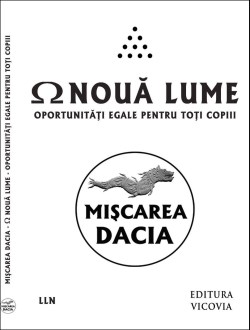 Vă invit să vă alăturaţi grupului Facebook Mişcarea DACIA, ce-şi propune un alt fel de a face politică!
Vă invit să vă alăturaţi grupului Facebook Mişcarea DACIA, ce-şi propune un alt fel de a face politică!Citiţi partea introductivă şi proiectul de Program, iar dacă vă place, veniţi cu noi !
O puteţi face clicând alături imaginea, sau acest link
Posts Tagged ‘Pitagora’
Apeiron
Hegel referred to the basic substance of the universe as “Geist”, a complex German word that expresses notions of both mind and spirit. Geist is dialectically evolving towards what Hegel called ‘the Absolute’ – God. The Absolute represents the complete control of the physical world by the mental. It is a state of Absolute Knowledge and Absolute Freedom. The Absolute understands itself perfectly. Hegel is often interpreted as an idealist, denying the existence of the physical, but in fact, like all Illuminists, he considered the physical and mental to be two aspects of a single substance.

However, he certainly regarded the mental as the dominant aspect of the single mind-matter reality – the dialectical process is all about bringing mind to its highest possible expression – and to that extent can be regarded as an idealist. Hence “Geist” is carefully chosen to emphasise the mental aspect.
There is no word that perfectly captures the nature of the basic substance of the universe: the arche, the first principle. The Ancient Greek philosopher Anaximander used the word “apeiron”, which is usually translated as “a substance without definition that gives rise to all things and to which all things return, a sort of primal chaos.”
Illuminists most usually use the word “Becoming” to describe the single fundamental substance of the universe. “Becoming” is technically an adjective rather than a noun, but Illuminists prefer this word over any other because it makes clear the difference between Illumination and the false religions of Being such as Christianity, Islam and Judaism.
“Becoming” emphasises the changing, dynamic nature of the universe, the evolutionary, dialectical aspect that drives the universe forwards and upwards. “Being” on the other hand is frozen, static, conservative, resistant to change. Mathematician Roger Penrose has proposed that there are three kinds of reality: physical, mental and mathematical, all connected in an unknown and deeply mysterious way. In fact there is only one reality, which presents itself in two ways: mind and matter.
Mathematics, it is true, is more than just a language created by the mind. It might be said to be a deep expression of Nietzsche’s Apollonian ordering principle that seeks to shape the Dionysian chaos. Mind and matter, if they are to avoid an existence of meaningless chaos, must have a strong core of order and organisation, a tendency to obey natural laws. That tendency will never be precise, but it will be reliable on average, hence the statistical emphasis of modern Quantum Theory.
Mind and matter both have mathematics built into them. Mathematics can be defined as the science of pattern. Mathematicians look for patterns in numbers and space, in the physical world and abstract worlds. The mind cannot help looking for patterns. Humans look at the clouds in the sky and start to see meaningful shapes. People have reported seeing the face of Jesus Christ on slices of toast. At all times, the mind tries to shape and pattern sensory data. All of this is mathematical in nature.
Baseball players, basketball players, American football players, soccer players and most other sportspeople engage in remarkable feats of intuitive mathematics. Think of the skill involved in catching a ball while on the run: the catcher is subconsciously calculating the speed of the ball, its trajectory, wind speed, his own speed, the conditions under his feet, the interception point, the orientation of his hands etc. The person involved may know nothing about mathematics as an academic subject, he might even be hopeless at the subject, yet he can solve this complex maths problem as he’s on the move without carrying out a single conscious calculation. Autistic savants can carry out prodigious calculations in their heads faster than professors can solve them with a calculator. These examples prove how deeply embedded in the psyche mathematics is.
The Ancient Greek philosopher Pythagoras – another great Illuminist (and the first to be identified with Illumination’s fundamental doctrine of the transmigration of souls) – claimed that numbers are the arche. He also said that a mathematical Law called Harmony controlled the universe. Pythagoras is associated with the mystical idea of the Music of the Spheres (also known as Musica universalis – universal music): the most beautiful and perfect music of all, which permeates the entire universe but can be heard only by God. Music is audible mathematics. It is the sound of the Apollonian order in the universe. It has such a powerful effect on us because it resonates with the mathematical intuitions buried within us. When we hear harmonies, we are listening to orchestrated numbers; we are directly experiencing universal order in the form of musical notes. Discordant music, jarring notes are the province of Dionysian disharmony.
Schopenhauer said that music was a “copy of the will itself” and there’s much truth in this. Illumination is a religion that holds mathematics in the highest regard and assigns to it an elevated status, but it is not a separate reality as Roger Penrose believes. It is part of the fabric of mind and matter. It is the language of the fundamental ordering principle.
Excerpted, page 161
© The Illuminati’s Secret Religion
Artwork by Joshua Hehe
Hyperian History Of The World (3rd Century)
“Hyperian History Of The World (3rd Century)
In the 3rd Century, the Hellenic world, centred on Alexandria, was awash in various, conflicting sects of Christianity, ranging from those more radical and more Jewish, to those more pagan, such as the Gnostic sects, as well as many other non-christian sects of Greek/Roman paganism. In the previous century, the religious element of these sects had taken precedence over any kind of intellectual, philosophical elements. But in the 3rd century, a great genius appeared in the world who would revive Greek philosophy and combine it with the religious sensibility of the time to produce a truly intelligent and intellectual religion. The Genius was Plotinus and his philosophical religion became known as Neoplatonism.
After travelling to Alexandria seeking philosophical wisdom, Plotinus came across a man called Ammonius Saccas, whose lectures on the philosophy of Plato so affected Plotinus that he immediately began studying under this new teacher. After many years of study under Ammonius Saccas, Plotinus began travelling around gaining further wisdom from Persian, Indian and Arab philosophers before finally settling in Rome towards the end of his life, where he spread his teachings around the great city.
Plotinus’s philosophical religion is basically the philosophy of Plato turned into a religion. Plotinus himself insisted that he was not creating anything new, but was rather producing the culmination of Plato’s philosophy. In the system of Plotinus, everything has its source in what he called The One. The One is essentially the arche, the source of everything. But for Plotinus, The One, as the source of everything, is very similar to Pythagoras’s concept of the point that contains all other points, i.e. The One is purely dimensionless and immaterial, yet contains within it everything else in the universe.
Plotinus’s system consists of a series of emanations starting from The One. The first thing that emanates from The One is The Nous, basically the same Nous as that of Anaxagoras. The Nous is the mind or the intellect of the universe, the thing that guides it and controls it. For Plotinus, the Nous contains within it all of the perfect Forms that Plato had spoken of. As the mind of the universe, the Nous knows everything about the universe and thinks all possible thoughts simultaneously.
The next emanation is the Psyche or the soul, emanating from the Nous. The Psyche is equivalent to Plato’s Demiurge. Whereas the Nous thinks everything simultaneously, the Psyche thinks slowly and as a linear process. The Psyche can access the Forms present in the Nous and use them to create the next emanation which is Nature, or the physical world, which is, as Plato said, an inferior copy of the Forms in the Nous. The Psyche is also split into two parts, firstly the upper part which is the World Soul, the collective soul of the world, and secondly, the lower part which takes the form of all the individual souls in the universe.
As these individual souls are only one emanation away from the physical world, Plotinus explains that these souls take the physical world to be true reality, when, in fact, True reality is mental rather than material, the true Forms in the Nous rather than the inferior copies of them in Nature. For Plotinus, the task of our souls is to leave behind the physical world and travel back up the emanations, firstly to the upper Psyche, or World Soul, then into the Nous itself where the True Forms are, and finally back to The One, which contains everything. This idea expands on Anaximander’s original concept that the universe begins as apeiron and shall return to apeiron.
Unfortunately, Plotinus’s religion, based on reason, rationality and mathematics, as well as the ideas of the greatest of geniuses of Ancient Greece, failed to take hold of Europe which, instead, adopted the absurd, irrational, faith-based version of Christianity which took over the Roman empire.
Of course, it is not too late to abandon the absurdity that is Christianity and revive the brilliant ideas of Plotinus, a religion which would far better have served the Romans and, indeed, the rest of the world. A religion based on reason, philosophy and mathematics is precisely what the world needs right now. The central idea can be summed up by Plotinus’s supposed last words: “Try to raise the divine in yourselves to the divine in the all.” If that’s not Hyperian, I don’t know what is.”
– Azure Circe – Hyperian

Istoria Hiperiană a lumii (secolul al IV-lea î.Hr., Partea I)
Tags: Anaxagoras, Apollo, Dionis, Forme, Heraclit, HiperUmanitate, Hyperianism, Parmenide, Pitagora, Platon, Raţiunea, Socrate
Cheia Existenţei
„Cheia existenței se află în cele două cifre intim legate: Zero și Infinit. Monadologia lui Leibniz plasează Zero în centrul Existenței. Fiecare Monadă este un punct matematic fără dimensiuni care ocupă spațiul fizic Zero (de aici, o Monadă poate fi asimilată ontologic cu numărul Zero). Mai mult decât atât, fiecare Monadă are o capacitate infinită pe care o putem numi “Energie” sau capacitatea nesfârșită de a efectua Operații Matematice (ceea ce este cu adevărat Energia). Potrivit Matematicii Ontologice, numerele sunt arche – substanța fundamentală a existenței, și toate provin de la Zero, Monada.
Zero Ontologic, originea, conține toate celelalte Numere, adică zero ontologic în mod inerent cuprinde fiecare alt număr. Aceasta este una dintre definițiile-cheie ale Zero-ului Ontologic: este ceea ce acționează ca şi container pentru o infinitate de numere. Zero și Infinit sunt legate indisolubil în Matematica Ontologică. La fel ca și zero ontologic are o semnificație reală (în afară de a fi un container pentru toate celelalte numere, Zero este și un Punct Matematic și punctele matematice sunt baza Matematicii, deci a Realității însăși), astfel încât toate numerele au o semnificație reală.
În matematica ontologică, fiecare număr este de fapt un val sinusoidal (val sinus sau cosinus), cu numărul specificând frecvența undei, adică un Număr dpdv. ontologic, este o Frecvență a Undelor. Un val sinusoidal este realitatea ontologică a “energiei”. Energia mai mare înseamnă o frecvență mai mare, ceea ce înseamnă un număr mai mare. Fiecare număr este codificat în realitate ca o măsură a energiei. Numărul 12 poate părea o abstractizare, dar ontologic se referă la un val sinusoidal de frecvență de 12 unități (unde “unitățile” se referă comparativ la un val sinusoidal de frecvență 1, valul “de bază”). Toate numerele pot fi caracterizate ontologic ca valuri sinusoidale, iar toate combinațiile de numere sunt combinații ontologice ale unor astfel de valuri. Aşa construim un întreg Univers “făcut” din Numere, exact așa cum a afirmat Pitagora în fraza sa nemuritoare: “Toate Lucrurile Sunt Numere”. Ceea ce a vrut să spună în termeni mai puțin abstracţi este că toate numerele sunt valuri de energie.
Mulţumită descoperirilor sale muzicale, Pitagora a fost obsedat de Armonia Cosmică. El a fost descoperitorul faptului profund că înjumătățirea lungimii pe o coardă a unei Lire a generat o notă de o octavă mai mare. Cu alte cuvinte, relațiile dintre numere sunt codate fizic (muzical, prin unde sonore, ca în cazul unei lire). Anumite combinații bazate pe rapoarte de numere întregi sunt armonioase și prospere, în timp ce alte combinații sunt instabile și se estompează în dezacord și uitare. Aici vedem baza teoriei moderne a undelor (mecanica cuantică) și teoria corzilor (care este adesea descrisă în termeni de analogie muzicală).
Posedând o Minte Intuitivă Divină, Pitagora a înțeles că întregul univers era ca un sistem cosmic de muzică, ghidat de armonii și astfel a ajuns la conceptul său sublim al Muzicii Sferelor, orchestrația cosmică a Existenței. Sferele cele mai exterioare ale cosmosului se mișcă cel mai rapid și fac notele cele mai înalte, în timp ce sferele cele mai interioare care se mișcă încet furnizează notele mai joase. Raiul nu este altceva decât o Orchestră Matematică, sunând simfonia creată de compozitorul divin – Dumnezeu.”
– Illumination
29.03.2019

Tags: Adevăr, Armonie, Dezarmonie, Energie, Frecvenţe, Infinit, Leibniz, Matematica Ontologică, Monada, Muzica Sferelor, Numere, Pitagora, Zero
Cavalerii Mesei Rotunde
http://armageddonconspiracy.co.uk/

Tags: Alchimie, Alexandria, Arthur, Britania, Camelot, Catharism, Cavaleri, Graal, Masa Rotundă, meritocraţie, Merlin, Nietzsche, Oraş-Stat, Perfectae, Perfecţii, Pitagora, Privilegiu, Roma, Templieri, Ubermenschen












